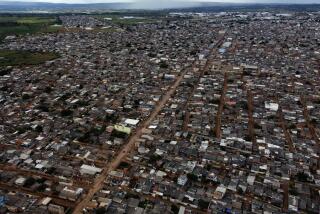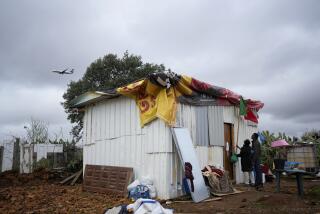Side Trips to Four Towns
- Share via
I planned on about 250 miles of driving around the northern towns near Porto, three days and two nights. If I had it to do again, though, I’d give myself another night, and perhaps stray a bit farther inland to the wine-country town of Lamego. But I still managed to see plenty of four northern towns.
Not much English is spoken in any of them, but that doesn’t mean a traveler will be ignored. When I approached the hotel desk in Viana do Castelo to ask where the dining room was, the reservations agent faltered for a moment, then led me herself to the elevator, punched the appropriate button, then rode with me to make sure I reached my destination.
Viana do Castelo: About 60 miles north of Porto, Viana is a port town of 15,000 that got rich in the 16th century, sending its seafarers across the Atlantic for Newfoundland cod. Business is slower now. In the town park, vendors peddled antique knicknacks and old Angolan 50-escudo notes from that African nation’s days as a Portuguese colony.
In the city center, streets are mostly pedestrian and the shops lean heavily to tourist wares. In the Praca de Republica, a fountain bubbles in front of the skeleton of a 16th-century town hall, and on the well-preserved wall of a spooky 1589 poorhouse, gargoyle-ish faces stare blindly between flower baskets.
The church of Santa Luzia, visible for miles, surveys the town and coastline from atop a high hill. It’s reachable by hike, drive or funicular ride. My bed for the night was a few hundred yards behind the church, in the Pousada Santa Luzia, a handsome, comfortable lodging with great views and recently renovated rooms.
Barcelos: Fifteen miles southeast of Viana do Castelo, Barcelos is a modest little town with medieval walls and 18th-century churches, and an essential role in Portuguese tourism. Thanks to its craft workers’ skills and an old local folktale about a pilgrim who brought his chicken dinner back to life on a dinner plate, Barcelos is the birthplace of Portugal’s national tourist trinket: the Barcelos cockerel.
Shops all over Portugal peddle the pottery roosters, which are produced in all sizes and typically painted black and red, with yellow and blue highlights. But nowhere are the roosters more prevalent than in Barcelos, which stands next to the Cavado River and is known for its Thursday marketplace.
It was drizzling when I arrived, and a parade met me. Bass drums, snare drums, bagpipes. (Like the Irish, Welsh and Scots, the Portuguese have Celtic influences in their pre-Christian history.) It was the community’s annual Festas das Cruzes (festival of the crosses), and townspeople had turned out in mass. (Town celebrations are common in northern Portuguese towns from May through October, commemorating a traditional religious pilgrimage, a running of bulls, the life of a patron saint, or the harvest. Many travelers’ guidebooks offer rundowns of the most popular festivals.)
Twelve-foot clowns (operated by two-man teams hobbling around on shaky stilts) led the procession. I spent two hours browsing among the carnival games and food stalls, shadowing the marchers as they trooped down narrow lanes under the gaze of children in second-story windows.
Braga: The old Portuguese saying is that while Lisbon shows off, Coimbra studies, Porto works and Braga prays. Braga, about 15 miles east of Barcelos, served as the seat of archbishops from the 11th to 18th centuries, and counts about three-dozen churches. These days the medieval town is encircled by drab commercial sprawl and the population has surpassed 60,000, but the old quarter is full of interesting buildings, beginning with the cathedral, which combines features from the 12th to 18th centuries. Up the street (known as Avenida dos Combatentes for most of its length), the town opens to the public spaces of the Praca Repu blica and Avenida Central, a promenade neighbored by half a dozen sidewalk eateries, most notably the well-situated Astoria and Viana cafes.
About three miles east of the city center stands the Bom Jesus, foremost religious landmark in Northern Portugal, built between 1784 and 1811. Pilgrims climb flight after flight of ornate outdoor stairs and eventually reach a towering stone church. The rest of the hilltop is given over to a sprawling green park, picnic grounds, a handful of restaurants and hotels, even a pond where visitors can putter around in brightly painted wooden rowboats.
Guimara~es: A great town, at once young and old. Guimara~es (population about 22,000) was the seat of Portuguese royalty in the early 12th century, before the capital moved to Coimbra, and a seven-towered castle from that century stands just uphill from the old quarter.
Like Braga, Guimara~es is surrounded by dreary modern commercial and residential growth, but all improves in the old city center. The Pousada da Oliveira, a hotel converted from a 16th-century row house, had stone walls and atmospheric old dark wood furniture and paneling. Its restaurant is renowned as one of the best in the region, and dinner that night was tremendous: mixed seafood soup; a chicken-and-rice dish with intriguing ham overtones; and a semi-soft cheese from Portugal’s Serra da Estrella region that tasted like an orange flower blossoming in my mouth.
The old quarter’s architecture features medieval highlights, from the old city walls to the 14th-century church next to the pousada.
Also, four miles southeast of Guimara~es, on commanding Penha hill, stands the Pousada de Santa Marinha de Costa, an enormous former monastery that now serves as a fancy hotel. It was built in the 12th century, largely rebuilt in the 18th. Even if you don’t stay there, a meal at the restaurant and a ramble through its many halls, past the azulejos and manicured gardens, are well worth the detour. (I have to assume that the swimming pool, whirlpool, tennis courts and running track were added after the monks’ departure.)
(BEGIN TEXT OF INFOBOX / INFOGRAPHIC)
GUIDEBOOK: Porto Side Trips
Where to stay: In Viana do Castelo: Pousada do Monte de Santa Luzia (4900 Viana do Castelo; tel. 011-351-58-82-88-89, fax 011-351-58-82-88-92). Great hilltop views, good restaurant (entrees up to $22). Brochure rates: $115 per night, double occupancy, $75 from November through March.
In Guimara~es: Pousada da Oliveira (Rua de Santa Maria, Apt. 101, 4801 Guimara~es, Portugal; tel. 011-351-53-514-157, fax 011-351-53-514-204). A former row house in the old quarter. Top-notch restaurant specializing in regional cuisine. Entrees up to $18. Brochure rates: $110 per night, double occupancy, $88 from November through March.
--C.R.
More to Read
Sign up for The Wild
We’ll help you find the best places to hike, bike and run, as well as the perfect silent spots for meditation and yoga.
You may occasionally receive promotional content from the Los Angeles Times.






